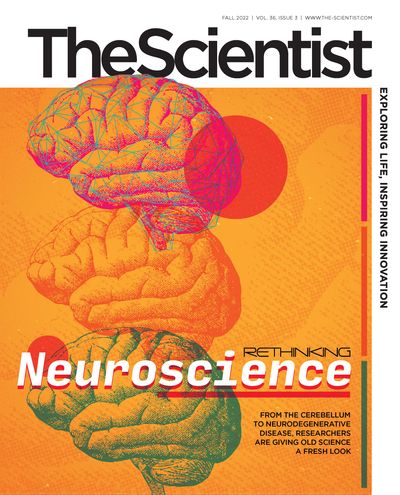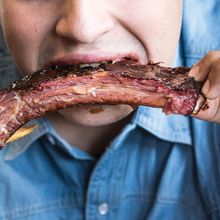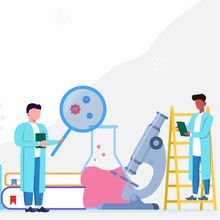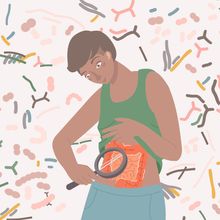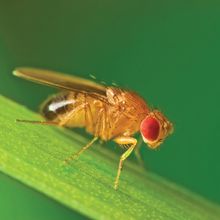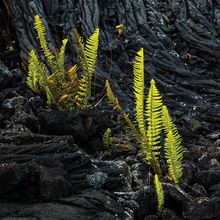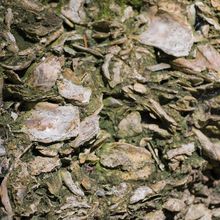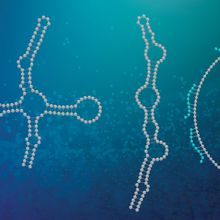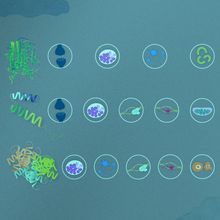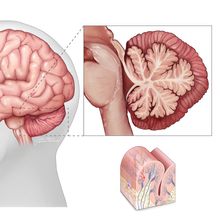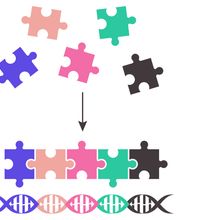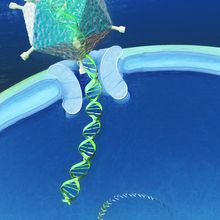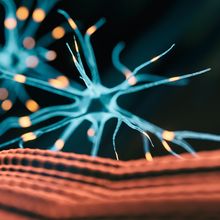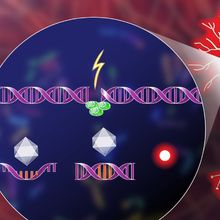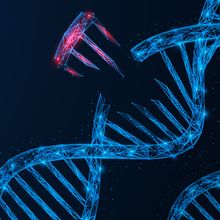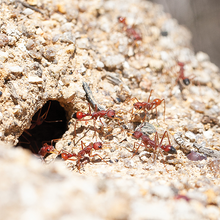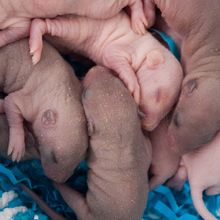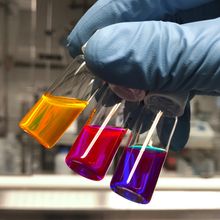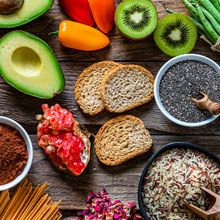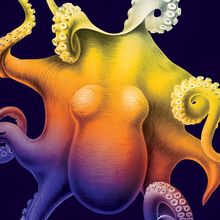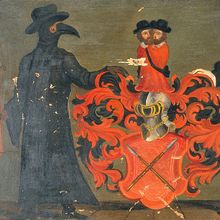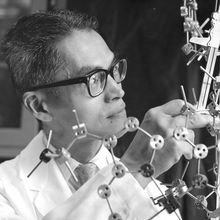Login
SubscribeFeatures
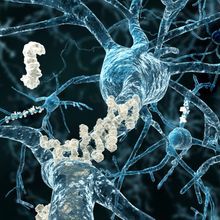
The Misunderstood Proteins of Neurodegeneration
Catherine Offord | Aug 1, 2022 | 10+ min read
The normal functions of peptides that aggregate in Alzheimer’s, Parkinson’s, and Huntington’s have been largely overlooked by scientists, but some argue that they are critical for understanding the development of disease.
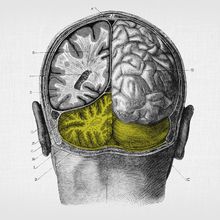
The Cerebellum’s Functions in Cognition, Emotion, and More
Diana Kwon | Aug 15, 2022 | 10+ min read
Once thought of as a mere motor coordination center, the “little brain” is now appreciated as participating in higher neurological processes.
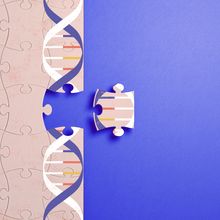
Large Scientific Collaborations Aim to Complete Human Genome
Brianna Chrisman and Jordan Eizenga | Sep 1, 2022 | 10+ min read
Thirty years out from the start of the Human Genome Project, researchers have finally finished sequencing the full 3 billion bases of a person’s genetic code. But even a complete reference genome has its shortcomings.
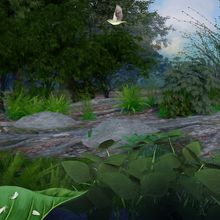
Horizontal Gene Transfer Happens More Often Than Anyone Thought
Christie Wilcox, PhD | Jul 5, 2022 | 10+ min read
DNA passed to and from all kinds of organisms, even across kingdoms, has helped shape the tree of life, to a large and undisputed degree in microbes and also unexpectedly in multicellular fungi, plants, and animals.
Editorial
Wonders Without, Wonders Within
Wonders Without, Wonders Within
As humanity peers ever further into the cosmos, the similarities and differences between our universe and our inner workings emerge.
Speaking of Science
Notable Science Quotes
Notable Science Quotes
Taking stock of the CDC's COVID-19 response, the importance of forest science, the evolutionary importance of chewing, and more
Critic at Large
Opinion: Many Clinical Trials Fail to Navigate the Literature
Opinion: Many Clinical Trials Fail to Navigate the Literature
Too often, studies that aim to develop new treatments for patients fail to adequately cite and build upon research that preceded them.
Opinion: Splashing Cold Water on Poop Transplants for Weight Loss
Opinion: Splashing Cold Water on Poop Transplants for Weight Loss
Gut microbiome–based solutions hold promise for addressing obesity, but are they overhyped?
Notebook
The Sex Appeal of Symmetric Songs
The Sex Appeal of Symmetric Songs
Female fruit flies assess the physical symmetry of male suitors through the songs they sing, a study claims.
The Unusual Functions of Geosmin
The Unusual Functions of Geosmin
The compounds responsible for the earthy smell of recent rain are produced by a wide variety of bacteria and fungi. Recent research sheds light on why microbes bother.
Why Did Ferns Persist When All Other Plants Perished?
Why Did Ferns Persist When All Other Plants Perished?
A strange layer in the fossil record contains evidence that fern populations exploded following the mass extinction that ended the Cretaceous period. Scientists want to know why.
Scientists Use Sound to Attract Baby Oysters Back to the Reef
Scientists Use Sound to Attract Baby Oysters Back to the Reef
Meet the team trying to restore mollusk populations with the help of underwater speakers.
Infographics
Infographic: Noncoding RNA in the Brain
Infographic: Noncoding RNA in the Brain
Neurologically important noncoding RNAs come in many shapes and sizes.
Infographic: Secret Lives of Neurodegeneration-Linked Proteins
Infographic: Secret Lives of Neurodegeneration-Linked Proteins
Maligned peptides such as the Alzheimer’s-associated amyloid precursor protein may have critical roles in the healthy brain.
Infographic: The Cerebellum’s Many Roles Beyond Motor Control
Infographic: The Cerebellum’s Many Roles Beyond Motor Control
Researchers have discovered that the small structure is involved in language, emotion, and many other high-order brain processes.
Infographic: The Sequencing and Assembly of the Human Genome
Infographic: The Sequencing and Assembly of the Human Genome
With ever-advancing genetic technologies, researchers continue to document the genetic code of the human species.
Infographic: Possible Mechanisms of Gene Transfer in Eukaryotes
Infographic: Possible Mechanisms of Gene Transfer in Eukaryotes
Genetic studies have made it clear that eukaryotic horizontal gene transfer can and does happen. Exactly how, though, remains speculative.
Infographic: Vangl2 in Muscles Keeps Neuromuscular Junctions Organized
Infographic: Vangl2 in Muscles Keeps Neuromuscular Junctions Organized
Genetic knockout experiments reveal a role for the protein in forming and maintaining synapses between motor neurons and muscle fibers in mice.
Infographic: DNA Damage Viewed with Unprecedented Clarity
Infographic: DNA Damage Viewed with Unprecedented Clarity
A new genetic sensor called PRISM makes use of a host cell’s DNA replication machinery to trigger fluorescence in neurons with damaged DNA.
Scientist to Watch
Humsa Venkatesh Probes Cancer’s Grip on the Brain
Humsa Venkatesh Probes Cancer’s Grip on the Brain
At Brigham and Women’s Hospital, the cancer biologist is combining research into the tumor microenvironment with the principles of neuroscience to tease apart how cancers grow—and how to stop them.
Clinton Cave Investigates How Brain Cells Communicate
Clinton Cave Investigates How Brain Cells Communicate
The Middlebury College neuroscientist explores enzymes that affect brain cell development and neurodegeneration.
Modus Operandi
DNA Damage Viewed with Unprecedented Clarity
DNA Damage Viewed with Unprecedented Clarity
A new tool called PRISM draws on virus-host interactions and a DNA repair pathway to help researchers visualize how cellular stress may contribute to neurodegenerative disease.
The Literature
A Novel Player at the Neuromuscular Junction
A Novel Player at the Neuromuscular Junction
The muscle transmembrane protein Vangl2 helps organize the development and maintenance of connections between muscles and motor neurons, a study concludes.
Protein-Recycling Process Protective Against Arterial Plaques
Protein-Recycling Process Protective Against Arterial Plaques
A team of scientists has found that in mice, a cellular housekeeping pathway protects against a major cause of heart attacks and strokes.
Bull Ant Venom Evolved to Make Bites More Painful to Mammals
Bull Ant Venom Evolved to Make Bites More Painful to Mammals
A peptide found in bull ant venom closely resembles a hormone of its primary predator, triggering hypersensitivity and making subsequent bites even more painful than the ones that came before.
Mother’s Circadian Rhythms Mirrored in Fetal Rat Brains
Mother’s Circadian Rhythms Mirrored in Fetal Rat Brains
Before their own central clocks develop, the brains of fetal rats detect their mother’s metabolic cycle to help regulate the expression of certain genes.
Human Gut Bacteria Show Up in Urban Wildlife
Human Gut Bacteria Show Up in Urban Wildlife
The gut microbiomes of city-dwelling animals, including coyotes, lizards, and birds, show similarities to those found in humans who also live in urban environments.
Careers
What If Scientists Shared Their Reagents for Free?
What If Scientists Shared Their Reagents for Free?
Some researchers have decided to provide their products without financial compensation or expectations of authorship on resulting papers, prompting a flurry of new work.
How to Fix Science's Code Problem
How to Fix Science's Code Problem
Despite increasingly strict journal policies requiring the release of computational code files along with research papers, many scientists remain reluctant to share—underscoring the need for better solutions.
Reading Frames
Opinion: Why We Fall for Fad Diets
Opinion: Why We Fall for Fad Diets
Human beings are susceptible to the latest nutritional trends, regardless of their actual biological value.
Opinion: Animal Dreaming Should Give Us Ethical Pause
Opinion: Animal Dreaming Should Give Us Ethical Pause
Research shows that humans aren’t the only animals whose imaginations run wild while they sleep.
Foundations
Masking Up, 1619 to Present
Masking Up, 1619 to Present
Putting on a mask to protect oneself and others against disease is nothing new, nor is resistance to mask-wearing, but mask designs have changed considerably from their first iterations.
Handmade Hemoglobin, 1912-2012
Handmade Hemoglobin, 1912-2012
Makio Murayama, a Japanese-American biochemist who was turned away from the Manhattan Project due to his heritage, rose to prominence for his work uncovering the link between the structure of hemoglobin and the mechanisms of sickle cell disease.
